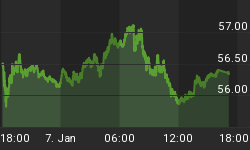Much is being written about the decline in the U.S. Dollar and the rising Euro and British Pound but we would like to ask, "What's Up with the Canadian Dollar?" Perhaps, we should ask, is the loonie getting loonie on us?
As most of our readers are investors in precious metals mutual funds, mining shares or long-term warrants on the mining shares we have a short-term problem. You see most of the mining companies are Canadian companies and our investment dollars in the above vehicles are thereby impacted at least short-term to the direction of the Canadian Dollar.
Canada is one of only a few countries with very large natural resources production and exports. Commodities including the base and precious metals, are in a bull market and consequently the Canadian Dollar should be performing at stellar levels, but it is not.
Quite the contrary, the Canadian Dollar is tracking the anemic U.S. greenback southward. On Friday, December 8th with the large rise in the U.S. Dollar, the Canadian Dollar did virtually nothing. Seems we cannot get a break here, good or bad.
From a fundamental basis, the reason we see for the decline and the short-term (we hope) predicament for the Canadian Dollar is due to the recent proposed changes in the Canadian income tax laws with respect to all Canadian Royalty Income Trusts. However, the major impact is on the oil and gas sector. Many investors, Canadian and U.S. and others) have been thrown into shock at the decline in value of their trusts and are currently in a dilemma in terms of what to do. This we feel is the basis of the problem with the loonie over which we as investors have no control.
Some explanation of course, is the slowing economy in Canada as written up by Min Zeng at Bloomberg on December 9th.
Another article written by Jeffrey Jones of Reuters on November 2, 2006, titled, "Tax move seen transforming Canada oil asset market" is in our opinion more to account for the recent plunge in the Canada Dollar. The markets hate taxes and uncertainty and in Canada you have both together at the same time which cannot be a good thing.
Can we gain any relief, at least in the short-term by looking at the charts? Below we visit the daily and weekly charts for the Canadian Dollar as of Friday December 8th, 2006. While it is still very early we see, or is it merely wishful thinking, the first possible signs of positive divergence in the relative strength and fast stochastics on the daily chart. We will know more in the coming days and weeks but it is difficult for us to see the Canadian Dollar falling much below its current level compared to the US greenback.



Keeping things in perspective, we look at a long term chart of the loonie back to 1986 and we see it touched a low in 2002 of 63, remember? So long term the situation is not as dire as one would gather from analyzing merely the short term charts. We would conclude the loonie is consolidating within the framework of a long term upward trend and is actually only slightly below the recent highs of 91 earlier this year as we can see in the above chart.
All of us as investors in the natural resource sector would like to see the Canadian Dollar remain strong if only because so many of our investment dollars are denominated in the loonie. Unfortunately, what we need and what we want is not what we always get. We shall see. While it will not be the end of the world to investors if the loonie does not substantially rebound, it will have the effect of limiting our future gains from our investments in the mining stocks, long-term warrants and other investments. If the prices of the commodities and metals continue to rise in the world markets it would be an added bonus if the currency in which they were denominated increased as well. We would benefit from the so called "double whammy" of an increase in the value of the equity and the currency in which it is denominated.
















